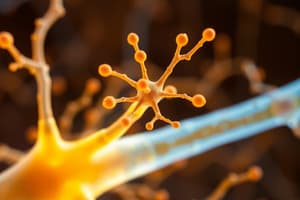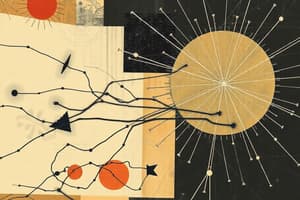Podcast
Questions and Answers
What are the five traditional senses through which the brain senses the surrounding environment?
What are the five traditional senses through which the brain senses the surrounding environment?
- hearing, vision, taste, smell, and somatosensation
- hearing, vision, taste, smell, and balance
- hearing, vision, touch, smell, and taste (correct)
- hearing, vision, taste, smell, and proprioception
What is the process by which somatosensory signals are converted into neural signals?
What is the process by which somatosensory signals are converted into neural signals?
- Modulation
- Transduction (correct)
- Perception
- Transmission
What is the term for the area of the body that is sensitive to a particular sensory receptor?
What is the term for the area of the body that is sensitive to a particular sensory receptor?
- Sensory modality
- Receptor specificity
- Receptor sensitivity
- Receptive field (correct)
What are the four attributes of sensory stimuli?
What are the four attributes of sensory stimuli?
What is the name of the system that subserves the submodality of somatic sensation related to proprioception?
What is the name of the system that subserves the submodality of somatic sensation related to proprioception?
What is the term for the ability of the brain to reorganize and adapt to changes in the body or environment?
What is the term for the ability of the brain to reorganize and adapt to changes in the body or environment?
What is the term for the degree to which a sensory receptor responds to a particular stimulus?
What is the term for the degree to which a sensory receptor responds to a particular stimulus?
What is the term for the ability of a sensory receptor to respond to a specific type of stimulus?
What is the term for the ability of a sensory receptor to respond to a specific type of stimulus?
What is the primary function of sensory receptors?
What is the primary function of sensory receptors?
What is the primary function of proprioceptors in the joint?
What is the primary function of proprioceptors in the joint?
What is the function of muscle spindles?
What is the function of muscle spindles?
How many types of mechanoreceptors are involved in touch?
How many types of mechanoreceptors are involved in touch?
What is the function of joint capsule receptors?
What is the function of joint capsule receptors?
What determines the receptive field size of mechanoreceptors?
What determines the receptive field size of mechanoreceptors?
What is the primary function of primary sensory neurons?
What is the primary function of primary sensory neurons?
What is the function of afferent signals from muscle spindles and efferent motor neurons?
What is the function of afferent signals from muscle spindles and efferent motor neurons?
What type of receptors are sensitive to changes in muscle tension?
What type of receptors are sensitive to changes in muscle tension?
What type of axons are most cold-sensitive fibres in humans?
What type of axons are most cold-sensitive fibres in humans?
What determines the receptor specificity of Nociceptors?
What determines the receptor specificity of Nociceptors?
How is information on intensity and duration of stimuli conveyed to sensory neurons?
How is information on intensity and duration of stimuli conveyed to sensory neurons?
What is the main function of Thermoreceptors?
What is the main function of Thermoreceptors?
What is the characteristic of 'hot' and 'cold' signals in thermoreception?
What is the characteristic of 'hot' and 'cold' signals in thermoreception?
How many main modalities of Nociceptors are there?
How many main modalities of Nociceptors are there?
What determines the threshold of activation of receptors?
What determines the threshold of activation of receptors?
What is the primary function of the dorsal columns tracts and the anterolateral system?
What is the primary function of the dorsal columns tracts and the anterolateral system?
What is an example of a maladaptive plasticity that can occur as a consequence of injury?
What is an example of a maladaptive plasticity that can occur as a consequence of injury?
What is the term used to describe the assessment of sensory cortical representation asymmetries in violin players?
What is the term used to describe the assessment of sensory cortical representation asymmetries in violin players?
What is the definition of the receptive field of a sensory neuron?
What is the definition of the receptive field of a sensory neuron?
What is the primary goal of therapies targeting maladaptive plasticity?
What is the primary goal of therapies targeting maladaptive plasticity?
What is the relationship between the two-point perceptual thresholds of different parts of the body and the diameters of the receptive fields of receptors?
What is the relationship between the two-point perceptual thresholds of different parts of the body and the diameters of the receptive fields of receptors?
What is the consequence of excessive synchronicity of stimuli in the context of learning?
What is the consequence of excessive synchronicity of stimuli in the context of learning?
What is the function of the dorsal columns/medial lemniscal system?
What is the function of the dorsal columns/medial lemniscal system?
What is the term used to describe the process by which the brain constructs a neural representation of external objects and our own bodies?
What is the term used to describe the process by which the brain constructs a neural representation of external objects and our own bodies?
What is the location where the contralateral anterolateral system crosses the midline in the spinal cord?
What is the location where the contralateral anterolateral system crosses the midline in the spinal cord?
What is the clinical relevance of somatosensory cortex plasticity?
What is the clinical relevance of somatosensory cortex plasticity?
What type of information is transmitted by the contralateral anterolateral system?
What type of information is transmitted by the contralateral anterolateral system?
What is the primary difference between how information is processed in the dorsal columns tracts and the anterolateral system versus how it is processed in other neural pathways?
What is the primary difference between how information is processed in the dorsal columns tracts and the anterolateral system versus how it is processed in other neural pathways?
What is the function of a dermatome?
What is the function of a dermatome?
What is the relationship between the dorsal root ganglion and a dermatome?
What is the relationship between the dorsal root ganglion and a dermatome?
What is the destination of the mechanosensory information transmitted by the dorsal columns/medial lemniscal system?
What is the destination of the mechanosensory information transmitted by the dorsal columns/medial lemniscal system?
Flashcards are hidden until you start studying
Study Notes
Somatosensory System
- The somatosensory system senses the surrounding environment and internal body
- It is not limited to touch, but includes other sensory modalities
Physiological Mechanisms of Sensation
- Transduction: conversion of stimulus energy into electrical signals
- Transmission: transmission of signals to the brain
- Perception: interpretation of signals by the brain
- Modulation: modification of signals by the brain
Somatosensory Receptors
- Specialized to transduce particular types of stimulus energy into electrical signals
- Different receptors have different transduction molecules and respond to different stimuli
- Examples:
- Mechanoreceptors (4 types) for touch
- Proprioceptors for limb position and movement
- Thermoreceptors for temperature
- Nociceptors for pain
Proprioceptors
- Joint receptors: report on limb position and movement
- Muscle spindles: regulate motor control of muscle length
- Golgi Tendon Organs: sense muscle tension
Thermoreceptors
- Respond to warm or cold stimuli in the non-noxious range
- Different populations of neurons signal 'hot' and 'cold'
- Most cold-sensitive fibers are small myelinated Aδ axons
- Most warm-sensitive fibers are small unmyelinated C axons
Nociceptors
- Respond to damaging or potentially damaging stimuli
- 4 main modalities: mechanical, thermal, chemical, and polymodal
- Different transduction molecules respond to different types of stimuli
Receptor Properties
- Modality: different receptors respond to different types of stimuli
- Intensity: encoded by firing frequency and number of receptors activated
- Duration: encoded by duration of firing and changes in spike trains
- Location: related to receptive fields
Somatosensory Axons
- Different types of axons have different conduction velocities
- Axons conveying different sensory modalities have different properties
Information Conveyance
- Firing rates of sensory neurons convey information on intensity and duration of stimuli
- Receptive field of a sensory neuron is the spatial domain where stimulation excites or inhibits the neuron
Somatotopic Maps
- Map of dermatomes in a typical adult: area of skin and deeper tissues innervated by a single dorsal root ganglion
- Important for determining location of suspected spinal lesions
Dorsal Columns/Medial Lemniscal System
- Conveys mechanosensory information from limbs and trunk to cortex via VPL thalamus
- Ascends ipsilaterally in spinal cord
Anterolateral System
- Conveys itch, temperature, and visceral information to cortex via brain stem and thalamus
- Crosses midline in spinal cord
Somatotopic Map Plasticity
- Use-dependent plasticity: assessment of sensory cortical representation asymmetries in violin players
- Clinical relevance: map plasticity may underlie pain following nerve injury, and can be exploited for functional recovery
Studying That Suits You
Use AI to generate personalized quizzes and flashcards to suit your learning preferences.




